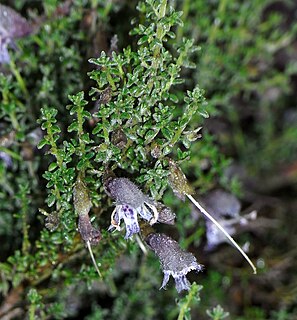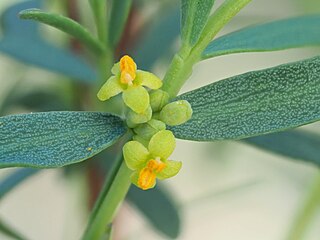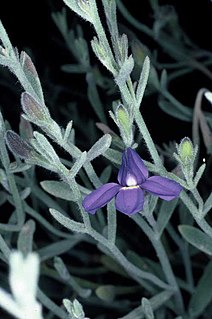
Pimelea spicata, commonly known as the spiked rice flower, is a flowering plant in the family Thymelaeaceae and is endemic to New South Wales. It is a slender plant with white flowers and elliptic leaves.

Prostanthera ovalifolia, commonly known as the oval-leaf mintbush or purple mintbush, is a species of flowering plant in the family Lamiaceae and is endemic to south-eastern continental Australia. It is an erect shrub with egg-shaped leaves and groups of mauve to deep blue-purple flowers arranged in groups at the ends of branchlets.

Prostanthera serpyllifolia, commonly known as small-leaved mint-bush, is a species of flowering plant in the family Lamiaceae and is endemic to southern Australia. It is a small shrub with small egg-shaped leaves and bright pink to red or metallic bluish-green flowers.

Pimelea glauca, commonly known as smooth riceflower, is a species of small shrub in the family Thymelaeaceae and is endemic to Australia. It is not considered to be threatened.

Pimelea pauciflora, commonly known as poison rice-flower, is a species of shrub in the family Thymelaeaceae. It has small yellow-lime flowers, green, smooth fleshy leaves and is endemic to Eastern Australia.

Pityrodia salvifolia is a flowering plant in the mint family Lamiaceae and is endemic to Queensland. It is an erect, spreading shrub with aromatic, wrinkled or corrugated leaves and clusters of small flowers with white petals. It is mostly found in wet forests in coastal north Queensland.

Pimelea angustifolia, commonly known as narrow-leaved pimelea, is a small upright, slender or open shrub with whitish, cream, yellow or pink flowers. It is endemic to Western Australia.

Pimelea curviflora, also known as curved rice-flower is a shrub in the family Thymelaeaceae and is endemic to Australia. It is a small, hairy shrub with greenish-yellow or red tubular flowers.

Prostanthera violacea, commonly known as violet mint-bush, is a species of flowering plant in the family Lamiaceae and is endemic to south-eastern New South Wales. It is a slender, strongly aromatic shrub with densely hairy branches, more or less round leaves with the edges rolled under and mauve to bluish flowers often with white tips.
Goodenia coronopifolia is a species of flowering plant in the family Goodeniaceae and is endemic to north-western Australia. It is a herb with mostly linear leaves, those at the base of the plant divided with narrow segments, racemes of yellow flowers with brownish-purple markings, and more or less spherical fruit.
Goodenia filiformis, commonly known as thread-leaved goodenia, is a species of flowering plant in the family Goodeniaceae and is endemic to near-coastal areas of south-western Western Australia. It is an erect to ascending herb with cylindrical to narrow linear leaves at the base of the plant and racemes of yellow flowers.

Goodenia incana is a species of flowering plant in the family Goodeniaceae and is endemic to the south-west of Western Australia. It is an ascending herb covered with silvery-white hairs, with linear to lance-shaped leaves mostly at the base of the plant, and racemes of blue flowers.

Goodenia pilosa is a species of flowering plant in the family Goodeniaceae and is native to northern Australia and to parts of Asia. It is a prostrate to low-lying herb with erect hairs, narrow oblong to narrow elliptic leaves at the base of the plant and racemes of yellow flowers with a purplish base.

Goodenia pterigosperma is a species of flowering plant in the family Goodeniaceae and is endemic to south-coastal areas in the south-west of Western Australia. It is an erect to sprawling, glabrous perennial herb or shrub with linear to lance-shaped leaves mostly at the base of the plant, and racemes of dark blue flowers.
Goodenia pumilio is a species of flowering plant in the family Goodeniaceae and is native to northern Australia and New Guinea. It is a prostrate, stolon-forming herb with egg-shaped to lance-shaped leaves in rosettes, and racemes of small, dark reddish-purple flowers.

Goodenia rotundifolia is a species of flowering plant in the family Goodeniaceae and is endemic to eastern Australia. It is a prostrate to erect perennial herb with more or less round, toothed leaves and racemes of yellow flowers.

Epacris crassifolia is a species of flowering plant in the heath family Ericaceae and is endemic to south-eastern New South Wales, Australia. It is a low-lying shrub with elliptic to egg-shaped leaves with the lower end towards the base, and tube-shaped, white or cream-coloured flowers clustered near the ends of the branches.

Leucopogon cuspidatus is a species of flowering plant in the family Ericaceae and is endemic to the central Queensland coast. It is a shrub with densely hairy young branchlets, egg-shaped to lance-shaped leaves with the narrower end towards the base, and white, bell-shaped flowers that are bearded inside.

Epacris mucronulata is a species of flowering plant in the heath family Ericaceae and is endemic to Tasmania. It is an erect shrub with softly-hairy young branches, lance-shaped leaves, and cylindrical white flowers in small groups at the ends of the branches.
Pimelea brevifolia is a species of flowering plant in the family Thymelaeaceae and is endemic to the south-west of Western Australia. It is an undershrub or shrub with erect, elliptic leaves, and heads of white flowers surrounded by four involucral bracts.
















